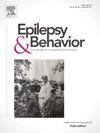暗示性癫痫诱导技术在儿科功能/分离性癫痫发作:一个广泛的协议
IF 2.3
3区 医学
Q2 BEHAVIORAL SCIENCES
引用次数: 0
摘要
功能性/解离性癫痫(FDS)是复杂的神经精神事件,经常被误诊为癫痫,特别是在儿童和青少年中。准确和及时的诊断仍然具有挑战性,特别是当标准或延长的脑电图记录未能捕捉到典型的发作。本回顾性研究评估了一种结构化的、非侵入性的暗示性癫痫诱导技术(SSIT)与视频脑电图相结合的诊断功能和临床相关性。疑似FDS患儿25例(平均年龄14.7岁;发病= 13.1年;72%的女性),所有之前接受过不确定的标准脑电图(在48%的病例中,也是非诊断性的延长脑电图),包括在内。SSIT方案采用口头建议、音叉刺激和浸泡垫应用,平均持续时间为33.8 min (SD = 11.3)。52%的患者有癫痫发作反应,72%的患者有非特异性躯体形式或解离性反应。言语暗示和浸泡垫技术是最有效的,每种方法都能引起20%的参与者的癫痫发作反应。所有有癫痫发作SSIT反应的患者最终都接受了记录在案的FDS诊断,而对临床文献的回顾显示,在随访期间通过延长或标准脑电图获得了额外的诊断。心理评估显示,癫痫发作对言语暗示的反应与分离症状,特别是“失去控制”之间存在显著关联(p <;0.05),而在SSIT期间,较低的工作记忆得分也与较高的癫痫反应性有关(p <;0.05)。这些发现支持了ssit在逐步加速诊断中的潜在作用,并强调了分离性和认知因素在儿科FDS中的相关性。本文章由计算机程序翻译,如有差异,请以英文原文为准。
Suggestive seizure induction techniques in paediatric functional/dissociative seizures: an extensive protocol
Functional/Dissociative Seizures (FDS) are complex neuropsychiatric events frequently misdiagnosed as epilepsy, particularly in children and adolescents. Accurate and timely diagnosis remains challenging, especially when standard or prolonged EEG recordings fail to capture typical episodes. This retrospective study evaluated the diagnostic utility and clinical correlates of a structured, non-invasive Suggestive Seizure Induction Technique (SSIT) protocol integrated within video-EEG. Twenty-five paediatric patients with suspected FDS (mean age = 14.7 years; onset = 13.1 years; 72 % females), all of whom had previously undergone inconclusive standard EEGs (and in 48 % of cases, also non-diagnostic prolonged vEEGs), were included. The SSIT protocol employed verbal suggestion, tuning fork stimulation, and soaked pad application over a mean duration of 33.8 min (SD = 11.3). A seizure response was observed in 52 % of the total sample, and 72 % showed nonspecific somatoform or dissociative reactions. Verbal suggestion and soaked pad techniques were the most effective, each eliciting seizure responses in 20 % of participants. All patients with a seizure SSIT response ultimately received a documented FDS diagnosis, while the review of the clinical documentation revealed that additional diagnoses were achieved during follow-up via prolonged or standard EEG. Psychological assessments revealed a significant association between seizure responses to verbal suggestion and dissociative symptoms, particularly “loss of control” (p < 0.05), while lower working memory scores were also linked to higher seizure responsiveness during SSIT (p < 0.05). These findings support the potential role of SSITs in accelerating diagnosis within a stepwise framework and highlight the relevance of dissociative and cognitive factors in paediatric FDS.
求助全文
通过发布文献求助,成功后即可免费获取论文全文。
去求助
来源期刊

Epilepsy & Behavior
医学-行为科学
CiteScore
5.40
自引率
15.40%
发文量
385
审稿时长
43 days
期刊介绍:
Epilepsy & Behavior is the fastest-growing international journal uniquely devoted to the rapid dissemination of the most current information available on the behavioral aspects of seizures and epilepsy.
Epilepsy & Behavior presents original peer-reviewed articles based on laboratory and clinical research. Topics are drawn from a variety of fields, including clinical neurology, neurosurgery, neuropsychiatry, neuropsychology, neurophysiology, neuropharmacology, and neuroimaging.
From September 2012 Epilepsy & Behavior stopped accepting Case Reports for publication in the journal. From this date authors who submit to Epilepsy & Behavior will be offered a transfer or asked to resubmit their Case Reports to its new sister journal, Epilepsy & Behavior Case Reports.
 求助内容:
求助内容: 应助结果提醒方式:
应助结果提醒方式:


